Site Guide to the Great Blue Heron Nature Reserve
by Bruce and Joanne Clayton of Butterfly On My Shoulder
Drive through picturesque farmland surrounded by majestic mountains to the Great Blue Heron 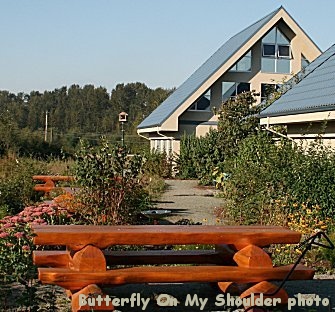 Nature Reserve located at the south end of Sumas Prairie Road. The Great Blue Heron Nature Reserve, formerly the Wet Bridging Area for the Department of National Defence, is now a protected reserve for the Great Blue Heron. Home to a very large colony of nesting Great Blue Herons and a wide variety of rare birds, wildlife and vegetation on an undyked floodplain stretching for 130 hectares, it is managed by the City of Chilliwack and the Great Blue Heron Nature Reserve Society. The impressive Rotary Interpretive Centre was funded and constructed by the Rotary Club of Chilliwack and is maintained year 'round by the congenial volunteers of the society. Experienced staff members offer interpretive programs and art instruction for school groups and other interested parties. Nature Reserve located at the south end of Sumas Prairie Road. The Great Blue Heron Nature Reserve, formerly the Wet Bridging Area for the Department of National Defence, is now a protected reserve for the Great Blue Heron. Home to a very large colony of nesting Great Blue Herons and a wide variety of rare birds, wildlife and vegetation on an undyked floodplain stretching for 130 hectares, it is managed by the City of Chilliwack and the Great Blue Heron Nature Reserve Society. The impressive Rotary Interpretive Centre was funded and constructed by the Rotary Club of Chilliwack and is maintained year 'round by the congenial volunteers of the society. Experienced staff members offer interpretive programs and art instruction for school groups and other interested parties.
For more information check out their website www.chilliwackblueheron.com
You can wander the extensive trails from dawn to dusk daily and the Interpretive Centre will offer advice and binoculars during their hours of operation. Make sure that you do not leave valuables in your car.
The Great Blue Herons are most visible during their mass arrival in February until the young are 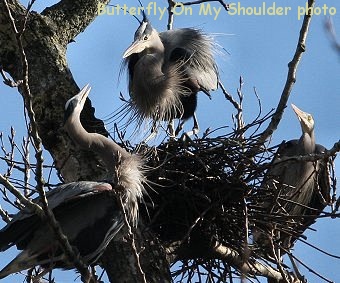 fledged in July. During this time, the gates to the trail that runs near the colony's nests are closed but it is possible to see the nesting birds by taking a walk along the dyke road that runs parallel to the reserve. Ask the volunteers at the Interpretive Centre how to get there and check out the live Heron cam in the Great Hall at the Centre, while you are there ask to borrow a pair of binoculars for better viewing. fledged in July. During this time, the gates to the trail that runs near the colony's nests are closed but it is possible to see the nesting birds by taking a walk along the dyke road that runs parallel to the reserve. Ask the volunteers at the Interpretive Centre how to get there and check out the live Heron cam in the Great Hall at the Centre, while you are there ask to borrow a pair of binoculars for better viewing.
Year 'round birds that visitors to the reserve will find are Great Blue Heron, Hooded Mergansers, Common Mergansers, Canada and Cackling Geese, Wood Ducks, Mallards, Black-capped Chickadee, Stellar's Jay, Bald Eagles, Northern Red-shafted Flickers, House Finches, Song Sparrows, Hairy Woodpeckers, Downy Woodpeckers, Bush Tits, Belted Kingfishers, Red-winged Blackbird, Bewick's Wren.
Autumn through the winter into early spring Double-crested Cormorants , American Wigeons, Ring-necked Ducks, Pied-billed Grebe, American Coot, Green-winged Teal, Buffleheads , Dark-eyed Junco, Golden-crowned Sparrow, Song Sparrows, Golden-crowned Kinglets, Ruby-crowned Kinglets, Golden Eagles, Pine Siskin, Marsh Wren, Pileated Woodpeckers, Brown Creepers join the permanent residents.
From early spring into autumn American Robin, American Goldfinch, Yellow Warblers, Common Yellowthroat Warblers, Wilson's Warblers, Swainson's Thrush, Stellar's Jays, Spotted Towhees, Black-headed Grosbeaks, White-crowned Sparrows, Fox Sparrows, Golden-crowned Sparrows, Lincoln's Sparrows, Green Heron, Blue-winged Teal, Cinnamon Teal join the permanent residents. Also Rufous Hummingbirds visit until mid July.
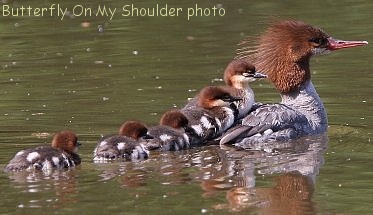
Swallows include the Barn Swallow, Cliff Swallow, Bank Swallow, Tree Swallow and Violet-green Swallow.
Falcons and Hawks of interest that have been seen are the Peregrine Falcon, American Kestrel, Cooper's Hawk, Sharp-shinned Hawk, Merlins, and Red-tailed Hawks.
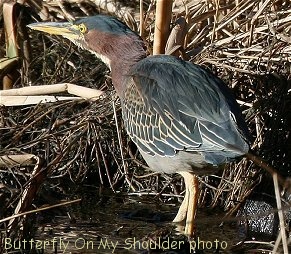 Some less common sightings Barrow's Goldeneye, Canvasback, Redhead Ducks, Northern Shovelers, Ruddy Ducks, Horned Grebe, Red-necked Grebe, Eurasian Wigeon, Lazuli Buntings , Bullock's Oriole, Western Tanager, Winter Wren, Varied Thrush, Eastern Kingbirds, Western Kingbirds, and Wilson's Snipe. Some less common sightings Barrow's Goldeneye, Canvasback, Redhead Ducks, Northern Shovelers, Ruddy Ducks, Horned Grebe, Red-necked Grebe, Eurasian Wigeon, Lazuli Buntings , Bullock's Oriole, Western Tanager, Winter Wren, Varied Thrush, Eastern Kingbirds, Western Kingbirds, and Wilson's Snipe.
Early spring and fall migrants can be very exciting, Yellow-rumped Warblers, Black-throated Grey Warblers, Evening Grosbeaks, Orange-crowned Warblers stop for awhile on their way through the area.
All these wonderful birds draw a group of mammal predators that are also interesting, included here are Mink, Otters and Bobcat .
In the spring and summer Deer with Fawns can be seen.
All year long, Beavers, Cottontail Rabbits and Raccoons are present.
Tree Frogs, Red-legged Frog, Green-frogs, Dragonflies , a wide variety of Butterflies and an incredible array of wildflowers, plants and native trees give visitors a choice of things to see while visiting a pleasant, natural setting with many pathways and benches. Take a picnic lunch and sit at the lovely picnic tables in the gardens behind the Interpretive Centre while looking out over the reserve. It is a lovely place to spend a day with family and friends.
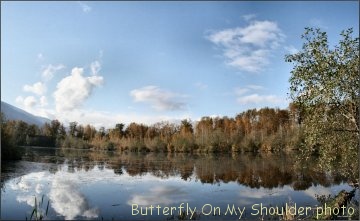
|